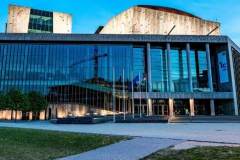Víkingur Ólafsson, István Várdai and the Franz Liszt Chamber Orchestra
May 2026 | ||||||
|---|---|---|---|---|---|---|
Mo | Tu | We | Th | Fr | Sa | Su |
It is not exclusively Hungarians that Müpa Budapest honours with the prestigious title of Artist of the Season: foreign musicians, such as the Russian piano virtuoso Denis Matsuev, for instance, have also been distinguished in this way. The prerequisites are obvious: a high level of professional excellence and a fruitful relationship with Müpa Budapest. Both conditions are easily met by Víkingur Ólafsson, the 41-year-old pianist The New York Times described as “Iceland’s Glenn Gould”, whose profound and inspired playing has lit up the Béla Bartók National Concert Hall on several occasions. In May 2026, he will join the world-famous Franz Liszt Chamber Orchestra (under the baton István Várdai, the ensemble’s artistic director and last year’s Artist of the Season) to perform Beethoven’s enchanting Piano Concerto No. 5 in E flat major in the second part of a concert that opens with Olli Mustonen’s Nonett and Haydn’s Symphony No. 93 in D major.
Program and cast
Conductor: István Várdai
Piano: Víkingur Ólafsson
Franz Liszt Chamber Orchestra (concertmaster: Péter Tfirst)
Program
Olli Mustonen - Nonett, No. 2
Haydn - Symphony No. 93 in D major, Hob I:93
Beethoven - Piano Concerto No. 5 in E-flat major, Op. 73
Palace of Arts Müpa Budapest
When Müpa Budapest, Hungary and its capital's new cultural hub, opened in 2005, it was built to represent more than 100 years of Hungarian cultural history. As a conglomeration of cultural venues, the building has no precedent in 20th century Hungarian architecture and has no peers in the whole of Central Europe.
The creators of this ambitious project, the Trigránit Development Corporation, prime contractor Arcadom Construction and the Zoboki, Demeter and Partners Architectural Office, were driven by the desire to create a new European cultural citadel as part of the new Millennium City Centre complex along the UNESCO World Heritage-listed Danube waterfront. The result is a facility whose construction quality, appearance, functionality and 21st century technological infrastructure makes it ideally suited to productions of the highest standard. The building is also highly versatile and equipped to host performances of any genre and almost any scale.

 EN
EN DE
DE IT
IT FR
FR ES
ES RU
RU JP
JP RO
RO
 Seating plan
Seating plan 
